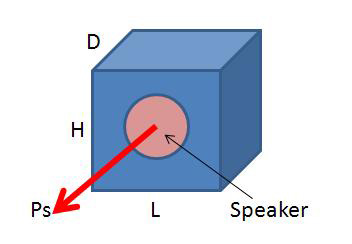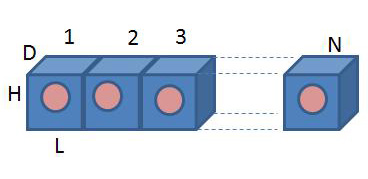Cutting Edge Sound Technologies for Consumer Electronics
3D-FYE™ How To Guide
System design is easy with 3D-FYE technology
3D-FYE is highly scalable and flexible, which enables many options in the number of speakers, size and type of speakers, and shape of the array configuration.
But because there are so many possibilities, one may find it difficult to select one and get started. Here is a roadmap to simplify the design process.
A Systematic Approach to Practical, Efficient Array Designs
We at Infinite Algorithms have developed many arrays and much know-how, and can provide any level of system design support, from basic suggestions all the way to complete designs.
For those considering doing all of the system design themselves, the following guidelines will streamline the process and get you quickly started on the development of a cutting-edge product.
In a sound bar or integrated 3D-FYE system, the designer has to select:
- N = the number of speakers
- Ps = the sound pressure level (SPL) produced by each speaker when driven at the desired power level at 1 meter on axis
- Vs = the required internal enclosure volume for each speaker
- FL = the desired low-frequency response of the array (not including a subwoofer)

Then an array system is created by joining individual speaker units as shown below:

The total SPL produced by the array equals Ps plus 3dB for each doubling of the number of speakers. In other words, if 1 speaker produces 80dB, then 2 speakers produces 83dB, 4 speakers produces 86dB, 8 speakers produces 89dB, etc.
The total internal volume required for the 3D-FYE speaker system = N x Vs.
The designer has the choice of choosing various combinations of L, H and D for each speaker so long as L x H x D = Vs.
After deciding on N, the number of speakers, the system designer then has to determine how to create a power amplifier with N channels, each with the power required to produce Ps from the selected speaker.
There is a wide range of choices of power amplifiers. To help select the best amplifier for a given design, here are a few key points to consider:
- Power, distortion and load impedance ratings. These 3 specs are inter-related so be sure to consider them simultaneously.
- Number of channels. Some amplifiers are available as 1, 2 and/or 4 channels per IC. Designing multi-channel amplifiers is less expensive and more compact with multi-channel amplifier ICs.
- Heat dissipation. Class-D power amplifiers are more efficient and therefore dissipate less heat than linear power amplifiers with similar power output ratings. The difference may be negligible for low-power designs, but will become significant at high power.
- Analog vs. digital inputs. 3D-FYE signal processors have I2S digital inputs and outputs, so power amplifiers with I2S digital inputs can connect directly. This eliminates the need for D/A converters, which saves cost and removes a potential source of noise and distortion.
General Considerations
a. Array speaker positioning. 3D-FYE presents different sound waves to each listener’s left and right ears. In order to do this accurately, all array speakers must be facing in the general direction of the listeners. Aiming some speakers toward the side walls or toward the wall behind the TV or sound bar will degrade the effectiveness of the 3D Virtual Sound effect. b. There is an important exception to the above rule. Systems can have speakers facing downward so long as the path of the sound waves from each speaker to each listeners’ ears is simple and predictable. See the following illustration:Overall System Dimensions - What are the size constraints?
i. If the system is to be embedded into a TV, the width and depth limits are likely to be determined by the width and depth of the overall TV design. Height may be somewhat more flexible.
ii. If the system is to be a stand-alone home theater soundbar, the dimensions may not be as constrained, but may still be limited by the range of TVs with which it is to be compatible. For example, it may need to be compatible with most flat-panel TVs with screen sizes of 46” and greater, which would limit the width to about 42”. Is it to be an “on-wall” design, that is, one that has a depth compatible with flat-panel TVs when mounted on a wall? If so, that may limit the depth to 2” or less (the total depth of many TVs plus their wall-mount brackets). Other sound bars are designed to be placed on the shelf or tabletop directly under the TV, and therefore must be at least as deep as the TV stand, which may be on the order of 10” – 12”.
iii. Is there a vertical constraint? Sound bars on the market today range in height from 2” to more than 5”. This may be more a styling issue than an engineering constraint.
iv. Are there any areas where speakers cannot be located? For example, does the TV have a control panel or stand that makes certain areas unavailable for array speakers?
How many speakers?
a. The more speakers used, the greater the resolution and depth of the 3D Virtual Sound. We have developed many systems, some with as few as 8 speakers per array and others with as many as 32. Based on our experience, we recommend that extremely cost-sensitive systems, such as those embedded in TVs, start with 8 speakers. Budget permitting, this number can be increased to 12 or 16. For example, a family of TVs may employ 8 speakers in low-cost 40” models and 12 or 16 in high-end 60” – 65” models. This provides the same character of sound quality for all models, but with higher performance in proportion to the size and price. We also recommend starting with 8 speakers for low-cost sound bars and sound docks for mobile audio devices such as iPods, and increasing the number in proportion to size and price.
b. For high-quality sound bars, we suggest starting with 16 speakers and increasing the number in proportion to size and price. We have had excellent results with 16 speakers in a wide range of systems with 1”, 1.5” and 2” speakers, and driven by as little as 10 Watts per speaker.
c. For top-quality home theater systems with large projection TV screens, we recommend starting with 24 speakers, and increasing the number to 32 depending on the screen size. We developed such a system for use with a 100” 3D projection TV screen, which had a width of 87”. We used 32 two-inch speakers spaced approximately 2.6” apart (center to center). Its performance is superb, both spatially as well as in traditional high-fidelity criteria. One “audiophile” described the sound quality as “effortless”, meaning that the sound was smooth and natural, with no signs of strain or limitations.
What size speakers?
a. In compact applications, such as those embedded in TVs, or those in small products such as mobile sound docks, we recommend using speakers with cone diameters of approximately 1”. Devices with these dimensions are available with sufficient power handling and low-frequency performance.
b. In larger, more powerful home theater sound bars, we recommend using speakers with cone diameters in the range of 1.5” – 2”. These larger speakers are more efficient (produce louder sound from less amplifier power) and offer improved low-frequency performance.
c. For larger and more powerful systems, we recommend using coaxial speakers (woofer with tweeter mounted in the center) with woofer diameters of 3” or greater. Our technology puts no constraint on the maximum speaker size, but other factors such as the width of the TV screen are sure to create limitations that will dictate the maximum speaker size.
How much amplifier power per speaker is necessary?
a. Those familiar with electrical power and acoustical sound pressure level (SPL) measurements will find conventional wisdom to be a good guide. The total system power will be approximately equal to the sum of the contributions from each amplifier and speaker in the system. For example, if there are 8 speakers, each speaker is rated at 80dB sensitivity (at 1 Watt at 1 meter, which translates to 90dB at 10 Watts at 1 meter), and each speaker is driven by a 10 Watt amplifier, the resulting maximum SPL will be approximately 99dB at 1 meter. This SPL is competitive in today’s market and would satisfy nearly all home theater sound bar customers.
b. For low-cost TV and sound dock systems, 8 speakers driven by 2 – 3 Watts per speaker will produce SPLs competitive with other products in their market categories.
Of course, in addition to SPL, 3D-FYE systems will also produce realistic, immersive spatial sound, which other sound systems cannot.
What is the trade-off between speaker size and speaker power?
a. Larger speakers tend to be more efficient (produce louder sound from less amplifier power). This increased efficiency tends to be even greater at low frequencies. Therefore, when considering only SPL and low frequency performance (and not 3D Virtual Sound performance), a system engineer can achieve the same SPL with a smaller number of larger (more efficient) speakers, or by driving more amplifier power into the same number of speakers. 3D-FYE technology is compatible with both alternatives, but will produce improved 3D Virtual Sound with a greater number of speakers.
b. Before making such a tradeoff decision, be sure to consider the speaker sensitivity in the low-frequency range. Our technology provides sufficient frequency response equalization correction to flatten the response from just about any appropriate speakers. However, a low-frequency EQ boost also drives much more power into the speaker, which will cause clipping at a lower perceived volume level. For example, compare these 2 hypothetical systems:
i. Speaker A has a 2” diameter and a rated sensitivity of 80dB/W/m. When used with a recommended enclosure design, it produces this SPL all the way down to 100Hz.
ii. Speaker B has a 1” diameter and a rated sensitivity of 77dB/W/m. When used with a recommended enclosure design, it produces this SPL all the way down to 200Hz, and is 6dB less sensitive at 100Hz.
In this comparison, Speaker B requires 8 times more amplifier power (9dB) to produce similar performance to Speaker A. That may not be a problem when playing at low levels and not using most of the amplifier power. However, there may not be enough amplifier power available to drive Speaker B when playing at a higher level. Or, put another way, Speaker B requires an 80 Watt amplifier to perform similarly to Speaker A driven by a 10 Watt amplifier.
For a particular system design, 8 or more 80 Watt amplifiers may not be feasible, and it is better to use larger, more efficient speakers.
How can Infinite Algorithms help to get you started?
a. We have much system design experience and can help the system design engineer to balance all of the key variables (number of speakers, speaker size, amplifier power, enclosure size, low frequency performance, spatial sound quality) in a way that is most appropriate for a particular application.
b. We can model a system and predict its performance before any prototypes are built.
c. We can use the above model to program a development platform so that a prototype can be quickly be built and evaluated.
d. We can recommend amplifiers and speakers that best meet the performance and cost requirements.
e. We can recommend enclosure designs that produce optimum performance from the selected speakers.
f. We can interact with your industrial designers to stimulate creative designs and to assure that the designs do not constrain the audio performance.
g. We can assist in the acoustical fine-tuning to assure that the maximum performance is being extracted from the prototype, or teach you how to use the System Tools so that you can do the fine-tuning.
h. We can provide reference designs for the electrical circuitry for both the signal processing and the power amplifiers.
i. We can provide support to assure that the upstream circuitry (preamplifier, surround sound decoder, etc.) interface correctly with our signal processing.
In short, we can have you up and running quickly, assure that development goes smoothly and get your product into the market in minimal time.


